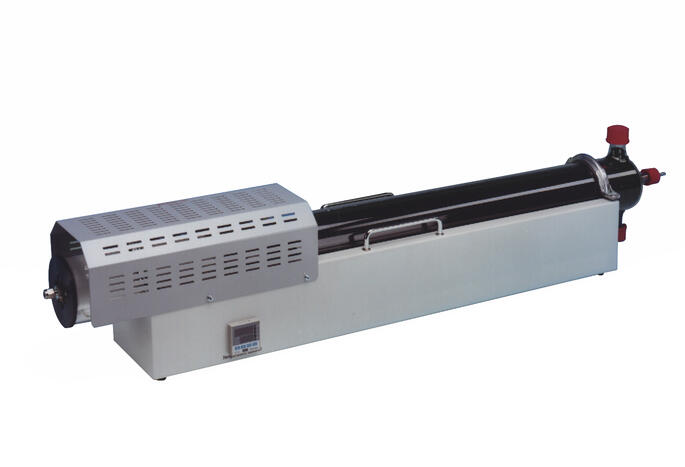TDD 590 Thermodenuder
Thermodenuder TDD 590 for removal of volatile organic components (VOC) from aerosols
For avoiding such measuring errors thermodenuders are used. By regulating the sample temperature such devices enable reducing moisture as well as volatile particles in the sample aerosol flow. Thus condensation processes during cooling down are widely prevented.
Standards
download
product sheet TDD 590Benefits
- efficent removal of volatile organic components (VOCs) from streaming gases or aerosols
- high efficiency due to high residence time and high temperature(temperatur control up to 400 °C)
- long operating life of the activated carbon by large storage capacity
- made of VOC inert material
- suitable as flexible laboratory equipment and as system element
Active carbon surrounding the flowpath of the particle-gas mixture removes the volatile compounds using the physical effect of adsorption. According to the adjusted temperature, specific components were extracted from the aerosol gas. The size distribution of particles in the aerosol is not influenced.
The hot aerosol or exhaust gas containing particles is directed into the thermodenuder where it is heated to a pre-set temperature. A built-in microprocessor controller displaying actual and set values is used to achieve precise adjustment of the temperature. The temperature can be varied easily with three or four touch keys at the temperature controller.
Volatile particles completely evaporate in the heating section. Hereby volatile particles are defined as particles evaporating during the residence time inside the thermodenuder at the pre-set temperature. Adsorbents in the aerosol diffuse to the surface of the active carbon due to the different concentration of the adsorbents between the volume with carbon and the gas.
As a result only solid particles are left in the aerosol. The TDD 590 thermodenuder operates with minimal loss as the particles never come in direct contact with the active carbon.
| Parameter title | Unit | Value |
|---|---|---|
| purpose of use | - | removal of volatile organic components (VOC) from sample flow rate |
| setting parameter | temperature | |
| setting range | °C | max. 400 |
| setting resolution | K | 1 |
| sample condition, outlet | - | aerosol/gas sample without volatile organic components |
| operating medium | - | activated carbon (6 L, grain size 2,5 mm) |
| volumetric flow rate, inlet | L/min | 0,1 ... 3,0 |
| sample condition, inlet | - | aerosol/gas sample with volatile organic components |
| power supply | - | 230 V AC, 50 ... 60 Hz (optional 110 V AC, 50 ... 60 Hz) |
| connector, inlet | - | 6 mm Swagelok |
| power consumption | W | 400 (350) |
| dimensions (w × h × d) | mm | 200 × 250 × 1200 |
| weight | kg | 11,5 |
- active charcoal
- Stevanovic S, Miljevic B, Madl P, Clifford S, Ristovski Z Characterisation of a commercially available thermodenuder and diffusion drier for ultrafine particles losses. Aerosol Air Qual. Res. 15 (2015) 1, 357-363
dx.doi.org/10.4209/aaqr.2013.12.035 - Lieke KI, Rosenorn T, Pedersson J, Kling J, Fuglsang K, Bilde M Micro- and nanostructural characteristics of particles before and after an exhaust recirculation system scrubber. Aerosol Sci. Technol. 47 (2013) 9, 1038-1046
dx.doi.org/10.1080/02786826.2013.813012 - Zeraati-Rezaei S, Zhang F, Xu H, Ghafourian A, Martin-Herreros J., Shuai S. Inestigation of two-stage split injection strategies for a Dieseline fuelled PPCI engine Fuel 107 (2013) 0, 299-308
dx.doi.org/10.1016/j.fuel.2012.11.048 - Park D, Kim S, Choi NK, Hwang J. Development and performance test of a thermo-denuder for separation of volatile matter from submicron aerosol particles J. Aerosol Sci. 39 (2008) 12, 1099-1108
dx.doi.org/10.1016/j.jaerosci.2008.07.002 - Wehner B, Philippin S, Wiedensohler A Design and calibration of a thermodenuder with an improved heating unit to measure the size-dependent volatile fraction of aerosol particles J. Aerosol Sci. 33 (2002) 7, 1087 - 1093
dx.doi.org/10.1016/S0021-8502(02)00056-3
